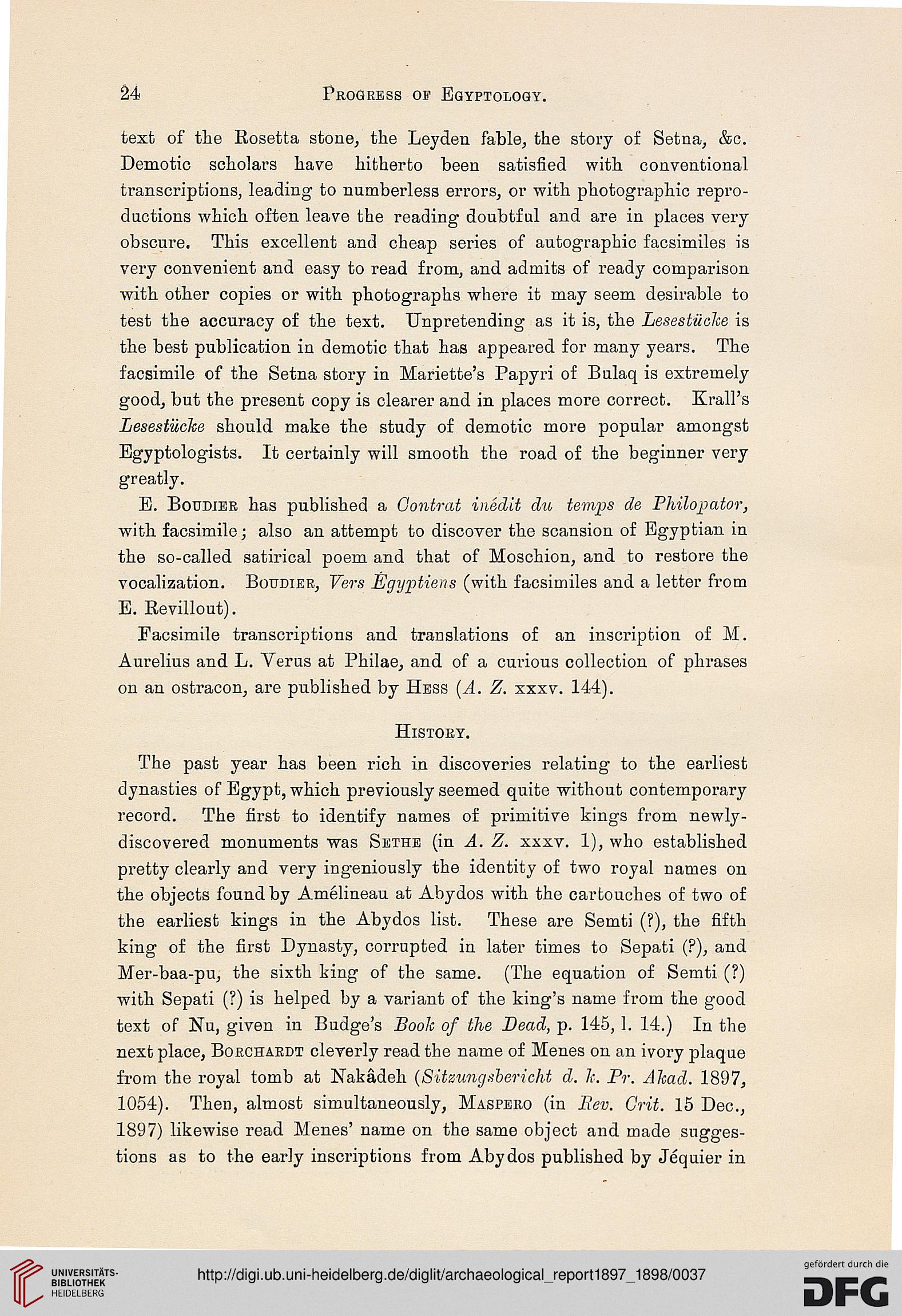24
Progress oe Egyptology.
text of the Rosetta stone, the Leyden fable, the story of Setna, &c.
Demotic scholars have hitherto been satisfied with conventional
transcriptions, leading to numberless errors, or with photographic repro-
ductions which often leave the reading doubtful and are in places very
obscure. This excellent and cheap series of autographic facsimiles is
very convenient and easy to read from, and admits of ready comparison
with other copies or with photographs where it may seem desirable to
test the accuracy of the text. Unpretending as it is, the Lesestiiche is
the best publication in demotic that has appeared for many years. The
facsimile of the Setna story in Mariette's Papyri of Bulaq is extremely
good, but the present copy is clearer and in places more correct. Krall's
Lesestiiche should make the study of demotic more popular amongst
Egyptologists. It certainly will smooth the road of the beginner very
greatly.
E. Boudjer has published a Oontrat inedit du temps de Philopator,
with facsimile; also an attempt to discover the scansion of Egyptian in
the so-called satirical poem and that of Moschion, and to restore the
vocalization. Boudier, Vers Egyptiens (with facsimiles and a letter from
E. Revillout).
Facsimile transcriptions and translations of an inscription of M.
Aurelius and L. Verus at Philae, and of a curious collection of phrases
on an ostracon, are published by Hess (A. Z. xxxv. 144).
History.
The past year has been rich in discoveries relating to the earliest
dynasties of Egypt, which previously seemed quite without contemporary
record. The first to identify names of primitive kings from newly-
discovered monuments was Sethe (in A. Z. xxxv. 1), who established
pretty clearly and very ingeniously the identity of two royal names on
the objects found by Amelineau at Abydos with the cartouches of two of
the earliest kings in the Abydos list. These are Semti (?), the fifth
king of the first Dynasty, corrupted in later times to Sepati (?), and
Mer-baa-pu, the sixth king of the same. (The equation of Semti (?)
with Sepati (?) is helped by a variant of the king's name from the good
text of Nu, given in Budge's Book of the Dead, p. 145,1. 14.) In the
next place, Borchardt cleverly read the name of Menes on an ivory plaque
from the royal tomb at Nakadeh (Sitzungsbericht d. h. Pr. Akad. 1897,
1054). Then, almost simultaneously, Maspero (in Rev. Grit. 15 Dec,
1897) likewise read Menes' name on the same object and made sugges-
tions as to the early inscriptions from Abydos published by Jequier in
Progress oe Egyptology.
text of the Rosetta stone, the Leyden fable, the story of Setna, &c.
Demotic scholars have hitherto been satisfied with conventional
transcriptions, leading to numberless errors, or with photographic repro-
ductions which often leave the reading doubtful and are in places very
obscure. This excellent and cheap series of autographic facsimiles is
very convenient and easy to read from, and admits of ready comparison
with other copies or with photographs where it may seem desirable to
test the accuracy of the text. Unpretending as it is, the Lesestiiche is
the best publication in demotic that has appeared for many years. The
facsimile of the Setna story in Mariette's Papyri of Bulaq is extremely
good, but the present copy is clearer and in places more correct. Krall's
Lesestiiche should make the study of demotic more popular amongst
Egyptologists. It certainly will smooth the road of the beginner very
greatly.
E. Boudjer has published a Oontrat inedit du temps de Philopator,
with facsimile; also an attempt to discover the scansion of Egyptian in
the so-called satirical poem and that of Moschion, and to restore the
vocalization. Boudier, Vers Egyptiens (with facsimiles and a letter from
E. Revillout).
Facsimile transcriptions and translations of an inscription of M.
Aurelius and L. Verus at Philae, and of a curious collection of phrases
on an ostracon, are published by Hess (A. Z. xxxv. 144).
History.
The past year has been rich in discoveries relating to the earliest
dynasties of Egypt, which previously seemed quite without contemporary
record. The first to identify names of primitive kings from newly-
discovered monuments was Sethe (in A. Z. xxxv. 1), who established
pretty clearly and very ingeniously the identity of two royal names on
the objects found by Amelineau at Abydos with the cartouches of two of
the earliest kings in the Abydos list. These are Semti (?), the fifth
king of the first Dynasty, corrupted in later times to Sepati (?), and
Mer-baa-pu, the sixth king of the same. (The equation of Semti (?)
with Sepati (?) is helped by a variant of the king's name from the good
text of Nu, given in Budge's Book of the Dead, p. 145,1. 14.) In the
next place, Borchardt cleverly read the name of Menes on an ivory plaque
from the royal tomb at Nakadeh (Sitzungsbericht d. h. Pr. Akad. 1897,
1054). Then, almost simultaneously, Maspero (in Rev. Grit. 15 Dec,
1897) likewise read Menes' name on the same object and made sugges-
tions as to the early inscriptions from Abydos published by Jequier in





